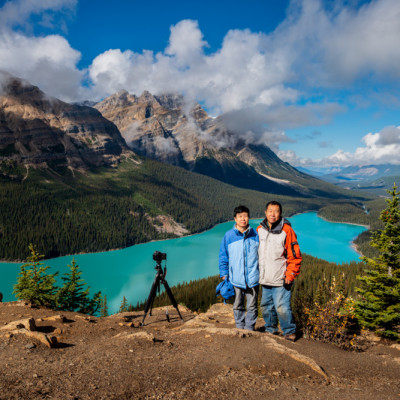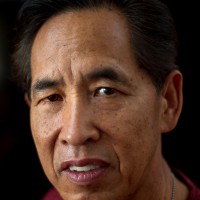SEARCH






|
|
|
|


by Editor HJ Yang
Edited and published by Yvette Depaepe, the 22nd of July 2024
When we were at Churchill tracking polar bear cubs in 2018, our guide, Thomas, we met during our first Antarctic trip in November of 2016, told us that there would be a unique opportunity to see emperor penguins in 2018, urging us to go. He told us that the last time people were able to see emperor penguins was 2009. We did not first jump in since we just went to Antarctic two years ago. However, he urged us again late during our trip and told us that he could go if he could find enough fund and ensured us that we would not regret going. So we took the chance.
'A star is born-A colony of emperor penguins near Snow Hill Island'
We arrived at Ushuaia, Argentina on November 11, 2018.
Ushuaia is the capital of Tierra del Fuego, Antártida e Islas del Atlántico Sur Province, Argentina. With a population of 82,615 and a location below the 54th parallel south latitude, Ushuaia claims the title of world's southernmost city.
Ushuaia is located in a wide bay on the southern coast of Isla Grande de Tierra del Fuego, bounded on the north by the Martial mountain range and on the south by the Beagle Channel. It is the only municipality in the Department of Ushuaia, which has an area of 9,390 km2 (3,625 sq mi). It was founded on 12 October 1884, by Augusto Lasserre and is located on the shores of the Beagle Channel surrounded by the mountain range of the Martial Glacier, in the Bay of Ushuaia. Ushuaia is located roughly 1,100 kilometres (680 mi) from the Antarctic Peninsula and is one of five internationally recognized Antarctic gateway cities.
We boarded the Russian (formerly Soviet) Kapitan Khlebnikov icebreaker ship next day.
The Kapitan Khlebnikov was completed in Finland in 1981 as one of four Kapitan Sorokin-class icebreakers. She was refitted in 1990 as a tour ship and was the first ship to circumnavigate Antarctica with passengers in 1996–97. In February 2006 the Kapitan Khlebnikov reached the Bay of Whales in the Antarctic, reaching 78° 40.871' south and equalling the record set by Roald Amundsen in the Fram in 1911. The Finnish-built icebreaker had been used as a cruise ship for several years and carries two helicopters before being stuck in the antarctic ice in 2009 with more than 100 guests, including scientists, tourists and journalists onboard. Our trip was the first time that the icebreaker returned to antarctic region since 2009 trip and carried less than 100 guests with similar mixed people. We had a French cinematographer, as our special guest, whom we met first in Ushuaia day before.
He with his co-worker spent a year in Antarctica's challenging weather conditions and isolated terrain to film the penguins in their natural habitat. The documentary follows the annual migration of emperor penguins in Antarctica, as breeding-age penguins leave the ocean in autumn to travel inland to their ancestral breeding grounds. The film also shows penguin parents caring for their eggs and chicks, and how the penguins exhibit a strong sense of family. The movie March of the Penguins was original in French and narrated by Morgan Freeman in English version.
After passed Drake passage, fought the ice in Weddell Sea, we finally arrived near Snow Hill Island on the 17th of November. On the way, we saw magic and wonders of icebergs with spectacular landscape.
Snow Hill Island is an almost completely snow-capped island, 33 km (21 mi) long and 12 km (7.5 mi) wide, lying off the east coast of the Antarctic Peninsula. It is separated from James Ross Island to the north-east by Admiralty Sound and from Seymour Island to the north by Picnic Passage. It is one of several islands around the peninsula known as Graham Land, which is closer to Chile, Argentina and South America than any other part of the Antarctic continent. The island was discovered on 6 January 1843 by a British expedition under James Clark Ross who, uncertain of its connection with the mainland, named it Snow Hill because its snow cover stood out in contrast to the bare ground of nearby Seymour Island.
Snow Hill Island is home to up to 10,000 Emperor Penguins, making it the northernmost location on the continent where these penguins can be found. Wild Emperor penguins are only found in Antarctica. They breed and raise their young mostly on ‘fast ice’, a floating platform of frozen ocean which is connected to the land or to ice shelves. From birth, they spend their entire lives in and around the Antarctic ice, although very rarely vagrants have turned up off the coast of New Zealand. Emperors are the biggest of the 18 species of penguin found today, and one of the largest of all birds. They are approximately 120cm tall (about the height of a six year old child) and weigh in at around 40 kg, though their weight does fluctuate dramatically throughout the year. Emperors are the least common Antarctic penguin, with global population estimates of 265,500–278,500 breeding pairs. Emperor penguin colonies have been discovered and counted from space. For the last 15 years, British Antarctic Survey (BAS) scientists have been looking for new colonies by searching satellite imagery for their guano stains on the ice. There are now 66 known emperor penguin colonies around the coastline of Antarctica. Emperors incubate their eggs during the long dark southern winter months. Courtship displays are intricate but copulation is quick and the female lays a single egg in May or June. She then passes it over to her mate to incubate - and she’s off. She spends the next nine weeks at sea, feeding. The male carefully balances the egg on his feet for between 65 – 75 days to keep it warm in a specially adapted brood pouch, and off the snow surface, before it hatches. Emperors are uniquely adapted to survive these harsh conditions when temperatures can drop down to a bone chilling -50°C and with winds of up to 200km/hr. They have two layers of feathers, a good reserve of fat and proportionally smaller beaks and flippers than other penguins to prevent heat loss. Emperors also have feathers on their legs, so their ankles don’t get too chilly. Even their feet are adapted to the icy conditions, containing special fats that prevent them from freezing and strong claws for gripping the ice. But most remarkably, colonies of adults and chicks work together to huddle for warmth. 5,000 or more tightly packed adults and chicks shuffle around, so each takes a turn - but not too long - on the outside of the huddle where it’s cold. This is in complete contrast to their quarrelsome and territorial neighbours, the Adélie penguins. Their strong sense of community literally keeps them alive. Their impressive size and colour makes them extremely popular and a favourite subject for wildlife photography.
In the morning of November 17, the weather was perfect with blue sky no cloud. Two helicopters first went out to find penguin colonies, then transport us to a place at least one kilometres away from the colony. We all then walked on the deep snow and march to the emperor penguin colony. It was a huge one. We all were very excited to finally see these giant penguins in wild. However, after only one hour or so, suddenly weather changed and snow storm came. We had to move back the temp tent, waiting helicopter to come to send us back to the mother ship. After that we only landed on island two more times, each seeing different penguin colonies, mostly under sunny condition.
It was amazing to watch these wonderful emperor penguins in their natural environment. As you could imagine that they never have seen any human in their life. So naturally they are not afraid of us. They sometimes would walk straight towards to us and peck whatever they found interesting to them.
Just look at them! They are so stunningly beautiful. They are the most impressive and beautiful penguins in all 18 penguins species. When we were watching them, playing, feeding baby and walking around, we were totally immersed in their environment and forgot ourself. By just watching them, we were receiving all kinds of emotional reaction, like magic. We could spend hours and hours, just watching them with endless wonder and wow.
As an artist, I am often wondering if I could really create any thing that could induce a better emotional impact to my viewer than these creatures do to us in their nature environment. Nature is the best teacher for all of us. We shall always learn from nature. So go to mountains, go to seas, go to the lands and go to wildness to observe, to feel and to learn. We shall respect and protect our environment and nature so our next generation could continue to observe, to feel and to learn from them.
'Tenor-An emperor penguin calling near Snow Hill Island'
'Strong family-A family of emperor penguins against windy snowing'
'Let me see'
'Brother, let me tell you-Two emperor penguins talks while walking together'
'Like father like son-Emperor penguin with chick in the snow'
'No tickle please, Dad-Emperor penguin chick with dad behind'
'Eyes right'
'Follow me'
'Little brother-Old emperor chick with a little one'
'three brothers'
'Thank you!'
About Editor Huijun (HJ) Yang, Ph.D.
Dr. HJ Yang, Scientist, Businessman and Nature Photographer, writes about his photo trips around the world and his personal view on art, science, philosophy and life experience. Some of his writings are below:
HJ Yang - Giving a voice to nature through photography
HJ Yang's Journey to Baffin Island
HJ Yang - Photography strongly connected to nature
HJ Yang's Journey: Patagonia Special Expedition
HJ Yang’ Journey: Tracking Polar Bear Cubs
Book
Wave Packets and Their Bifurcations in Geophysical Fluid Dynamics, Applied Mathematical Sciences, 85, Springer, 1991.
 | Write |
 | Sunny Lin PRO Thank you for going through so much trouble to get us such lovely pictures and explanations, it's so touching. Congratulations! |
 | Ineke Mighorst PRO Love the story, it must be fantastic to go there and photograph. |
 | Per Urmann A great expedition. Impressive pictures taken during this expedition. Really impressive images and a very expressive reproduction of the wilderness in the Antarctic. Magnificent! |
 | Wanghan Li PRO Very impressive article and the beautiful, artistic works! Love your words: "As an artist, I am often wondering if I could really create any thing that could induce a better emotional impact to my viewer than these creatures do to us in their nature environment. Nature is the best teacher for all of us. We shall always learn from nature. So go to mountains, go to seas, go to the lands and go to wildness to observe, to feel and to learn. We shall respect and protect our environment and nature so our next generation could continue to observe, to feel and to learn from them." Love your other articles and the works. |
 | HJ Yang CREW Thanks, Wanghan. |